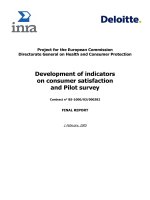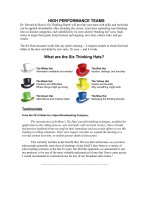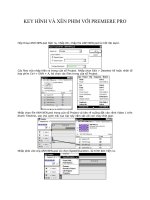Key Performance Indicators
Bạn đang xem bản rút gọn của tài liệu. Xem và tải ngay bản đầy đủ của tài liệu tại đây (950.8 KB, 255 trang )
Key Performance
Indicators
Key Performance
Indicators
Developing,
Implementing, and
Using Winning KPIs
DAV ID PARMENTER
John Wiley & Sons, Inc.
This book is printed on acid-free paper.
Copyright © 2007 by John Wiley & Sons, Inc. All rights reserved.
Published by John Wiley & Sons, Inc., Hoboken, New Jersey
Published simultaneously in Canada
No part of this publication may be reproduced, stored in a retrieval system,
or transmitted in any form or by any means, electronic, mechanical,
photocopying, recording, scanning, or otherwise, except as permitted under
Section 107 or 108 of the 1976 United States Copyright Act, without either
the prior written permission of the Publisher, or authorization through
payment of the appropriate per-copy fee to the Copyright Clearance Center,
Inc., 222 Rosewood Drive, Danvers, MA 01923, 978-750-8400, fax
978-646-8600, or on the web at www.copyright.com. Requests to the Publisher
for permission should be addressed to the Permissions Department,
John Wiley & Sons, Inc., 111 River Street, Hoboken, NJ 07030, 201-748-6011,
fax 201-748-6008, e-mail:
Limit of Liability/Disclaimer of Warranty: While the publisher and author have
used their best efforts in preparing this book, they make no representations
or warranties with respect to the accuracy or completeness of the contents of
this book and specifically disclaim any implied warranties of merchantability
or fitness for a particular purpose. No warranty may be created or extended
by sales representatives or written sales materials. The advice and strategies
contained herein may not be suitable for your situation. You should consult
with a professional where appropriate. Neither the publisher nor author shall
be liable for any loss of profit or any other commercial damages, including
but not limited to special, incidental, consequential, or other damages.
For general information on our other products and services, or technical
support, please contact our Customer Care Department within the United
States at 800-762-2974, outside the United States at 317-572-3993, or fax
317-572-4002.
Wiley also publishes its books in a variety of electronic formats. Some content
that appears in print may not be available in electronic books.
Library of Congress Cataloging-in-Publication Data:
Parmenter, David.
Key performance indicators : developing, implementing, and using
winning KPIs / David Parmenter.
p. cm.
Includes index.
ISBN-13: 978-0-470-09588-1 (cloth)
ISBN-10: 0-470-09588-1 (cloth)
1. Performance technology. 2. Performance standards.
3. Organizational effectiveness. I. Title.
HF5549.5.P37P37 2007
658.40'13— dc22 2006020849
Printed in the United States of America
10987654321
CONTENTS
Preface ix
Acknowledgments xv
Chapter 1 Introduction 1
Key Result Indicators 2
Key Performance Indicators 3
Management Models That Have a Profound
Impact on KPIs 10
Definitions 14
Chapter 2 Foundation Stones for Implementing
Key Performance Indicators 19
Four Foundaton Stones Guiding the Development
and Use of KPIs 20
Defining Vision, Mission, and Strategy 25
How to Implement Winning KPIs in 16 Weeks 26
Chapter 3 Developing and Using KPIs: A 12-Step Model 37
Step 1: Senior Management Team Commitment 39
Step 2: Establishing a “Winning KPI” Project Team 44
Step 3: Establish a “Just Do It” Culture and Process 49
Step 4: Setting Up a Holistic KPI Development Strategy 54
v
Step 5: Marketing the KPI System to All Employees 61
Step 6: Identifying Organization-Wide Critical
Success Factors 65
Step 7: Recording Performance Measures in a Database 72
Step 8: Selecting Team-Level Performance Measures 77
Step 9: Selecting Organizational “Winning KPIs” 85
Step 10: Developing the Reporting Framework
at All Levels 88
Step 11: Facilitating the Use of Winning KPIs 94
Step 12: Refining KPIs to Maintain Their Relevance 100
Chapter 4 KPI Team Resource Kit 105
Using This Resource Kit 105
Step 1 Worksheet: Senior Management Team
Commitment 106
Step 2 Worksheet: Establishing a Winning KPI
Team 112
Step 3 Worksheet: Establish a “Just Do It” Culture
for This Project 116
Step 4 Worksheet: Setting Up a Holistic KPI
Development Strategy 119
Step 5 Worksheet: Marketing the KPI System to
All Employees 125
Step 6 Worksheet: Identifying Organization-Wide CSFs 132
Step 7 Worksheet: Comprehensive Recording of
Measures within the Database 140
Step 8 Worksheet: Selecting Team Performance
Measures 140
vi
Contents
Step 9 Worksheet: Selecting Organization-Wide
“Winning KPIs” 142
Step 10 Worksheet: Developing Display, Reporting, and
Review Frameworks at All Levels 151
Step 11 Worksheet: Facilitating the Use of KPIs 152
Step 12 Worksheet: Refining and Modifying KPIs to
Maintain Their Relevance 159
Chapter 5 Templates for Reporting Performance
Measures 165
Reporting Key Result Indicators in a “Dashboard”
to the Board 166
Reporting Performance Measures to Management 173
Reporting Performance Measures to Staff 175
Graph Format Examples 180
Chapter 6 Facilitator’s Resource Kit 189
Remember the Fundamentals 190
Appendix Performance Measures Database 201
Index 233
Contents
vii
ix
PREFACE
This book is aimed at providing the missing link between the
balanced scorecard work of Kaplan and Norton
1
and the reality
of implementing performance measurement in an organization. The
implementation difficulties were first grasped by a KPI manual
developed by AusIndustry as part of a “portfolio” of resources for
organizations pursuing international best practices. This book has
adopted many of the approaches of the KPI manual, which was first
published in 1996, and has incorporated more implementation tools,
the balanced scorecard philosophy, the author’s work on “winning
key performance indicators” (KPIs), and many checklists to assist with
implementation.
EMBARKING ON A KPI/BALANCED
SCORECARD PROJECT
The goal of this book is to help minimize the risks that working on
a KPI/balanced scorecard project encompasses. It is designed for the
project team, senior management, external project facilitators, and
team coordinators whose role it is to steer such a project to success.
The role they play could leave a great legacy in the organization
for years to come, or could amount to nothing by joining the many
performance measurement initiatives that have failed. It is my wish
that the material in this book, along with the workshops I deliver
around the world, will increase the likelihood of success.
In order for both you and your project to succeed, I suggest that
you:
●
Read Chapters 1 and 2 carefully, a couple of times.
●
Visit my Web site www.waymark.co.nz for other useful infor-
mation.
●
Scan the material in the subsequent chapters so you know what
is there.
●
Begin Step 1 in Chapter 3 by setting up the focus group one-
day workshop.
●
Seek an outside facilitator, who will help guide/mentor you in
the early weeks of the project.
●
Commence the project team-building exercises and undertake
any training to plug those identified skill gaps in the project
team.
How to Use This Book
Due to the common misunderstandings that exist in relation to KPIs,
it is important that all project team members, management, and staff
are aware of the structure and content of this guide.
Using Chapter 1: Introduction
For years organizations that have had what they thought were KPIs
have not had the focus, adaptability, innovation, and profitability that
they were seeking. KPIs themselves were mislabeled and misused.
Examine a company with over 20 KPIs and you will find a lack of focus,
lack of alignment, and underachievement. Some organizations try
to manage with over 40 KPIs, many of which are not actually KPIs.
This chapter explains a new way of breaking performance measures
x
Preface
xi
Overview Target Audience
Chapter 1 Background. Draws on the latest theory as to All members of the KPI team, the external project facilitator,
differences between key result indicators team coordinators, local project facilitators, senior
(KRIs), performance indicators (PIs), and KPIs. management, and board members will need to read this
chapter to fully understand what KRIs, PIs, and KPIs are.
Chapter 2 The foundation stones for implementing KPIs. All members of the KPI team, the external project facilitator,
Discusses the four principles that need to be team coordinators, local project facilitators, and the
applied. senior management team will need to read this chapter to
fully understand the importance of these foundation stones.
Chapter 3 A 12-step model for developing and using KPI team, the external project facilitator, team coordinators,
KPIs. It is important that this chapter is fully local project facilitators, and individual team members who
understood before commencing the project. will be responsible for the development of PIs and KPIs.
Chapter 4 The KPI team’s resource kit including work- KPI team, the external project facilitator, team coordinators,
sheets, workshop programs, and questionnaires. and local project facilitators, who will be undertaking the
various exercises.
Chapter 5 Templates for reporting performance measures The project team, reporting accountants, and the senior
(including KRIs, PIs, and KPIs). management team. This chapter saves time by utilizing
better-practice reporting templates.
Chapter 6 External project facilitator’s resource kit. The project team, senior management, and the external
facilitator.
Appendix List of performance measures (including KRIs, KPI team, the external project facilitator, team coordinators,
PIs and KPIs) to assist with the short-listing of and local project facilitators, who will be overseeing the
likely performance measures. implementation.
xii
into key result indicators, performance indicators, and key perform-
ance indicators. It also explains a significant shift in the way KPIs
are used to ensure they do not create dysfunctional behavior.
Using Chapter 2: Foundation Stones for
Implementing Key Performance Indicators
Effective organizational change is heavily reliant on creating appro-
priate people practices as the centerpiece of a new workplace cul-
ture. In this context, the introduction of KPIs must be achieved in
a way that supports and extends the idea of a cooperative partnership
in the workplace —a partnership among employees, management,
suppliers, customers, and the communities in which the organization
operates. This chapter advances four general principles, called the
four foundation stones:
1. Partnership with the staff, unions, key suppliers, and key
customers
2. Transfer of power to the front line
3. Integration of measurement, reporting, and improvement of
performance
4. Linkage of performance measures to strategy
Using Chapter 3: Developing and Using KPIs:
A 12-Step Model
When you are ready to introduce performance measures (including
result indicators, performance indicators, and KPIs) into your orga-
nization, we anticipate that you will want to broadly follow the 12-step
approach outlined in this chapter. This chapter analyzes each step,
its purpose, how it relates to the four foundation stones, guidelines
on how to use it, and a checklist to ensure that the key steps are under-
taken.
Preface
xiii
Using Chapter 4: KPI Team Resource Kit
This chapter provides the KPI team with useful tools for gathering
information. For many of the steps, a questionnaire has been included
and, in some cases, a worksheet that needs to be completed by the
project team or by the teams developing their performance meas-
ures. For all key workshop sessions, a program has been developed
based on successful ones run by the author.
Using Chapter 5: Templates for
Reporting Performance Measures
This chapter illustrates how to present KRIs, PIs, and KPIs. Electronic
templates can be acquired from www.waymark.co.nz (for a small
fee). Readers who provide additional formats to KPIformats@
waymark.co.nz that are not already on the website will be able to get
a discount on this fee providing Waymark Solutions decides to use
them and are given the right to publish them.
Using Chapter 6: Facilitator’s Resource Kit
The process for developing and using performance measures (including
KRIs, PIs, and KPIs) is assisted by the involvement of a skilled KPI facil-
itator sourced from outside the company. The facilitator’s key roles
are to help educate the senior management team, set up the project
team, and then mentor the project team. Chapter 3 suggests that certain
key activities within the 12 steps should be performed by this external
facilitator.
Using the Appendix: Performance Measures Database
The appendix provides a list of performance measures (includ-
ing KRIs, PIs, and KPIs), some of which will be relevant for your
organization. These are organized according to balanced scorecard
Preface
perspectives and are constantly being updated. Updated versions are
available via www.waymark.co.nz (for a small fee). Readers who con-
tribute additional measures to will be
rewarded with a discount on this fee.
The manual is a resource for anyone in the organization involved
with the development and use of KPIs. It is desirable that all KPI
project team members, the external project facilitator, team coor-
dinators, and local facilitators (if required) have their own manual
to ensure all follow the same plan. Team members are expected to
take the manual with them when meeting staff and management,
as they will be able to clarify issues by using examples from the manual.
However, note that this manual is copyrighted, so it is a breach of
the copyright to photocopy sections for distribution.
Endnote
1. Robert S. Kaplan and David P. Norton, The Balanced Scorecard: Translating Strategy
into Action. Boston: Harvard Business School Press, 1996.
xiv
Preface
xv
ACKNOWLEDGMENTS
I would like to acknowledge the commitment and dedication of Way-
mark Solutions staff over the years this project has taken (Sean, Dean,
Jacqueline, Roydon); Debbie Parker, who read through the early drafts;
Nadra, Alexandra, and Claudine who have had to put up with my
many late nights at the office and finally all those who have attended
my KPI workshops and shared their ideas on “winning KPIs.”
Key Performance
Indicators
CHAPTER 1
Introduction
Many companies are working with the wrong measures, many of which
are incorrectly termed key performance indicators (KPIs). Very few
organizations really monitor their true KPIs. The reason is that very
few organizations, business leaders, writers, accountants, and consul-
tants have explored what a KPI actually is. There are three types of
performance measures (see Exhibit 1.1):
1. Key result indicators (KRIs) tell you how you have done in a
perspective.
2. Performance indicators (PIs) tell you what to do.
3. KPIs tell you what to do to increase performance dramatically.
Many performance measures used by organizations are thus an
inappropriate mix of these three types.
An onion analogy can be used to describe the relationship of these
three measures. The outside skin describes the overall condition of
the onion, the amount of sun, water, and nutrients it has received;
how it has been handled from harvest to supermarket shelf. However,
as we peel the layers off the onion, we find more information. The
layers represent the various performance indicators, and the core,
the key performance indicators.
1
KEY RESULT INDICATORS
What are KRIs? KRIs are measures that have often been mistaken
for KPIs, including:
●
Customer satisfaction
●
Net profit before tax
●
Profitability of customers
●
Employee satisfaction
●
Return on capital employed
The common characteristic of these measures is that they are the
result of many actions. They give a clear picture of whether you are
traveling in the right direction. They do not, however, tell you what
you need to do to improve these results. Thus, KRIs provide infor-
mation that is ideal for the board (i.e., those not involved in day-to-
day management).
A car’s speedometer provides a useful analogy. The board will
simply want to know the speed the car is traveling. However, man-
agement needs to know more information since the traveling speed
Key Performance Indicators
2
Exhibit 1.1 Three Types of Performance Measures
KRIs
Peel the skin to find the PIs
PIs
Peel to the core to find the KPIs
KPIs
is a combination of what gear the car is in and the revolutions per
minute (RPMs) of the engine. Management might even be concen-
trating on completely different measures, such as how economically
the car is performing (miles per gallon), or how hot the engine is run-
ning. These are two completely different gauges and are perform-
ance indicators or might even be KPIs.
KRIs typically cover a longer period of time than KPIs; they are
reviewed on monthly/quarterly cycles, not on a daily/weekly basis as
KPIs are. Separating KRIs from other measures has a profound impact
on reporting, resulting in a separation of performance measures into
those impacting governance and those impacting management. That
is, an organization should have a governance report (ideally in a
dashboard format), consisting of up to ten measures providing high-
level KRIs for the board and a balanced scorecard (BSC) comprising
up to 20 measures (a mix of KPIs and PIs) for management.
In between KRIs and the true KPIs are numerous performance
indicators. These complement the KPIs and are shown with them
on the scorecard for the organization and the scorecard for each divi-
sion, department, and team.
Performance indicators that lie beneath KRIs could include:
●
Profitability of the top 10% of customers
●
Net profit on key product lines
●
Percentage increase in sales with top 10% of customers
●
Number of employees participating in the suggestion scheme
KEY PERFORMANCE INDICATORS
What are KPIs?
KPIs represent a set of measures focusing on those aspects of
organizational performance that are the most critical for the current
and future success of the organization.
Introduction
3
KPIs are rarely new to the organization. They have either not been
recognized or were “gathering dust” somewhere unknown to the cur-
rent management team. KPIs can be illustrated by two examples:
Key Performance Indicators
4
This example concerns a senior BA official, who set about turning
British Airways (BA) around in the 1980s by reportedly concen-
trating on one KPI. He was notified, wherever he was in the
world, if a BA plane was delayed. The BA manager at the rele-
vant airport knew that if a plane was delayed beyond a certain
“threshold,” they would receive a personal call from the BA
official. It was not long before BA planes had a reputation for
leaving on time. This KPI affected all six of the BSC perspec-
tives. Late planes:
●
Increased cost in many ways, including additional airport
surcharges, and the cost of accommodating passengers
overnight as a result of planes being “curfewed” due to noise
restrictions late at night
●
Increased customers’ dissatisfaction, and alienation of those
people meeting passengers at their destination (possible
future customers)
●
Contributed more to ozone depletion (environmental im-
pact) as additional fuel was used in order to make up time
during the flight
●
Had a negative impact on staff development as they learned
to replicate the bad habits that created late planes
●
Adversely affected supplier relationships and servicing
schedules resulting in poor service quality
●
Increased employee dissatisfaction, as they were constantly
“firefighting” and dealing with frustrated customers
Example: An Airline KPI
Seven Characteristics
From extensive analysis and from discussions with over 1,500 par-
ticipants in my KPI workshops, covering most organization types in
the public and private sectors, I define seven KPI characteristics:
1. Nonfinancial measures (not expressed in dollars, yen, pounds,
euros, etc.)
2. Measured frequently (e.g., daily or 24/7)
3. Acted on by the CEO and senior management team
4. Understanding of the measure and the corrective action required
by all staff
5. Ties responsibility to the individual or team
6. Significant impact (e.g., affects most of the core critical success
factors [CSFs] and more than one BSC perspective)
7. Positive impact (e.g., affects all other performance measures
in a positive way)
Introduction
5
Example: A Distribution Company
A CEO of a distribution company realized that a critical success
factor for their business was trucks leaving as close to capacity
as possible. A large train truck capable of carrying more than
40 tons was being sent out with small loads as dispatch man-
agers were focusing on “delivering in full on time” to customers.
Each day by 9 A.M., the CEO received a report of those
trailers that had been sent out underweight. The CEO called
the dispatch manager and asked whether any action had taken
place to see if the customer could have accepted the delivery
on a different date that would enable better utilization of the
trucks. In most cases the customer could have received it earlier
or later, fitting in with a past or future truck going in that direc-
tion. The impact on profitability was significant.
Just with the airline example, staff did their utmost to avoid
a career-limiting phone call with their CEO!
When you put a dollar sign on a measure, you have already con-
verted it into a result indicator (e.g., daily sales are a result of activ-
ities that have taken place to create the sales). The KPI lies deeper
down. It may be the number of visits to contacts with the key cus-
tomers who make up most of the profitable business.
KPIs should be monitored 24/7, daily, or perhaps weekly for some.
A monthly, quarterly, or annual measure cannot be a KPI, as it cannot
be key to your business if you are monitoring it well after the “horse
has bolted.” KPIs are therefore “current-” or future-oriented mea-
sures as opposed to past measures (e.g., number of key customer visits
planned in next month or a list by key customer of the date of the
next planned visit). When you look at most organizational measures,
they are very much past indicators measuring events of the last month
or quarter. These indicators cannot be and never were KPIs.
All good KPIs make a difference; they have the CEO’s constant
attention, with daily calls to the relevant staff. Having a “career-
limiting” discussion with the CEO is not something the staff wants
to repeat, and in the airline case, innovative and productive processes
were put in place to prevent a recurrence.
A KPI should tell you what action needs to take place. The British
Airways “late plane” KPI communicated immediately to everyone
that there needed to be a focus on recovering the lost time. Cleaners,
caterers, ground crew, flight attendants, and liaison officers with traffic
controllers would all work some magic to save a minute here and a
minute there, while maintaining or improving service standards.
A KPI is deep enough in the organization that it can be tied to
an individual. In other words, the CEO can call someone and ask
“why.” Return on capital employed has never been a KPI, as it cannot
be tied to a manager —it is a result of many activities under different
managers.
A good KPI will affect most of the core CSFs and more than one
BSC perspective. In other words, when the CEO, management, and
staff focus on the KPI, the organization scores goals in all directions.
Key Performance Indicators
6









